Interview on Vatican secrets with Father Charles Theodore Murr / Part 2
Part 1 of this interview can be found here.
By Kevin J. Symonds, M.A.
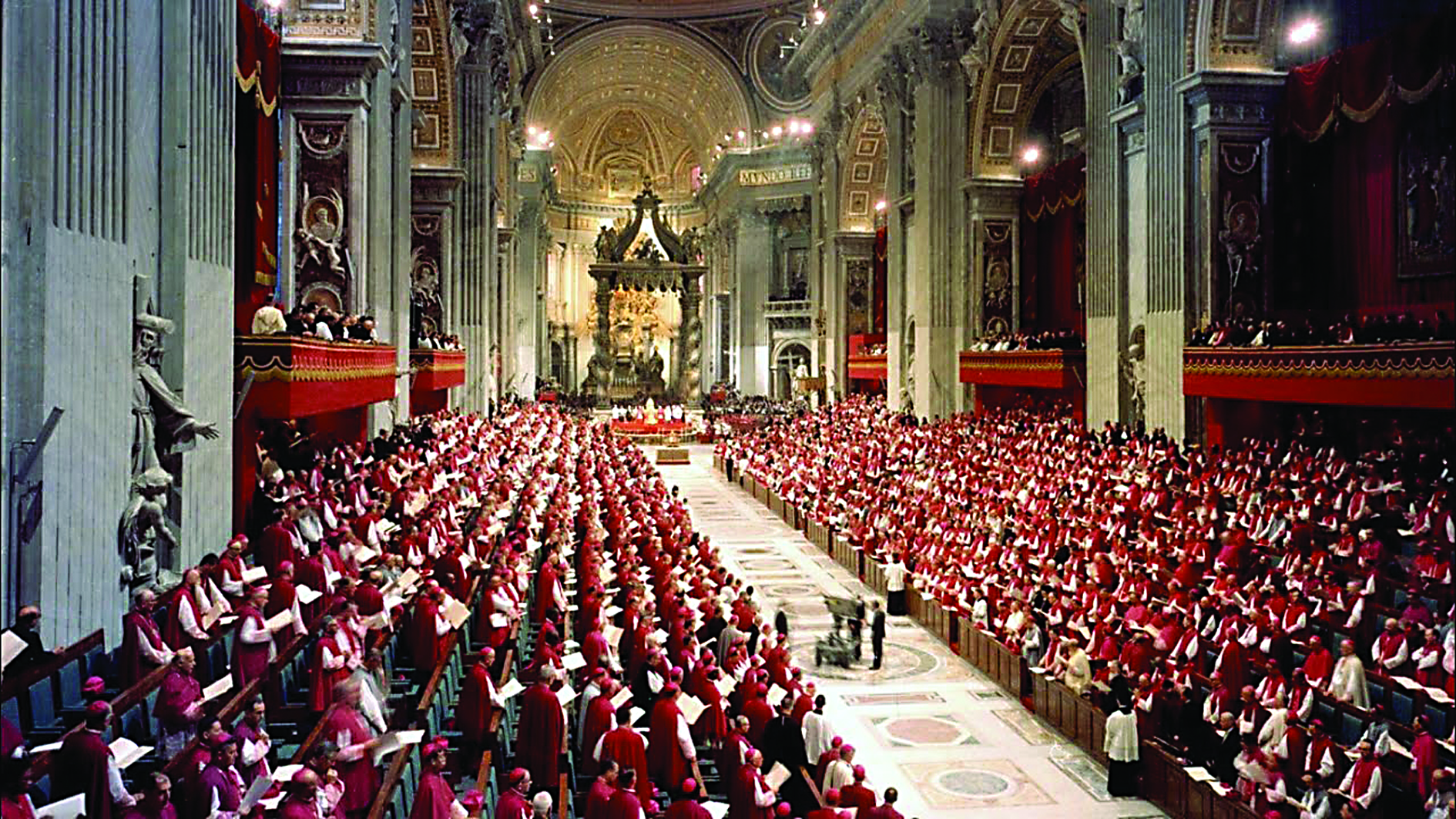
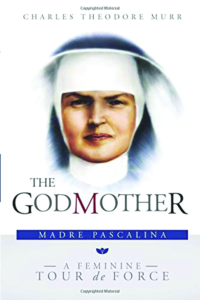
The Godmother: Mother Pascalina. A Feminine Tour de Force by Fr. Charles Theodore Murr, is available through Amazon. It was also recently translated into Italian and Spanish. Those editions are also available on Amazon
Fr. Charles T. Murr sat down for an interview for the October 2020 issue of Inside the Vatican about his book The Godmother (2017). Interested readers may want to read that interview first in order to gain more understanding of the context for the present one. In the previous interview, Fr. Murr told us about his friendship with Mother Pascalina Lehnert, the “right hand” of Pope Pius XII for several decades. In addition to this discussion, Fr. Murr made some notable revelations about what was going on at the Vatican in the 1960s and 1970s. The interview below follows up on these revelations with the theme of “Where do we go from here?”
ITV: Thank you, Fr. Murr, for sitting down again with Inside the Vatican. In our previous interview, you spoke of your association with Cardinal Edouard Gagnon and Msgr. Mario Marini. These two men worked closely with the Sostituto of the Secretariat of State, Cardinal Benelli, in the 1970s. You yourself, however, did not enjoy the same association with Cardinal Benelli…
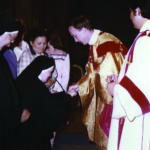 FR. CHARLES MURR: I was 24 years old when I met and became friends with the newly appointed minutante in the Vatican Secretariat of State, Monsignor Mario Marini. Soon after, Marini introduced me to another extraordinary man who would play a major role in my life, his good friend, Archbishop Edouard Gagnon (1918-2007). Gagnon and Marini were respected friends and confidants of Archbishop Giovanni Benelli (Sostituto of the Secretary of State). I was not part of that inner circle. I knew Benelli, of course, and spoke with him many times, but I knew my place. Once, on Lago di Bracciano, I was at table with him and Monsignors [Guillermo] Zanoni and Marini. I remember talking as little as possible. With Benelli, I knew my place and kept it.
FR. CHARLES MURR: I was 24 years old when I met and became friends with the newly appointed minutante in the Vatican Secretariat of State, Monsignor Mario Marini. Soon after, Marini introduced me to another extraordinary man who would play a major role in my life, his good friend, Archbishop Edouard Gagnon (1918-2007). Gagnon and Marini were respected friends and confidants of Archbishop Giovanni Benelli (Sostituto of the Secretary of State). I was not part of that inner circle. I knew Benelli, of course, and spoke with him many times, but I knew my place. Once, on Lago di Bracciano, I was at table with him and Monsignors [Guillermo] Zanoni and Marini. I remember talking as little as possible. With Benelli, I knew my place and kept it.
Why did you think of your relationship with Benelli in this way?
MURR: To begin with, Giovanni Benelli was Giovanni Benelli! He was one of the most powerful men on earth; brilliant, a strategizer and deal-maker par excellence, the #1 Vatican diplomat, a man on familiar terms with Popes and Princes, Patriarchs and Presidents, world leaders of all sorts. I, on the other hand, was a greenhorn American student of philosophy; absolutely no one of consequence. Those special times that I was privileged to be in Benelli’s company were times I knew I was in the presence of greatness.
Why did Pope St. Paul VI in 1973 appoint then-Archbishop Gagnon to be the Apostolic Visitator to the Roman Curia?
MURR: This was Archbishop Benelli’s call. Paul VI was convinced that “the smoke of Satan” had entered the Church (as he said publicly in June of 1972). In 1973, he called for an investigation of the entire Roman Curia. Benelli assured the Pope that he had just the man for the job: Edouard Gagnon. And as soon as Gagnon accepted the awesome responsibility, he “hit the ground running,” as the expression goes. At the Pope’s insistence, the in-depth investigation of the Roman Curia — no small assignment, let me assure you — was to be Gagnon’s full-time job, start to finish.
Other people helped Gagnon with the Visitation, yourself included. Could you name a few of these people and how they were involved?
MURR: Gagnon was assisted by several people during the three-year investigation. Most important among them was his trusted friend and compatriot, Msgr.Robert Tremblay. (I believe the good man has already gone to God). When Gagnon needed a second opinion on this or that legal matter, he called upon Msgr. Giuseppi Lobina, Professor of Law at the Lateran University. The archbishop was also assisted by a very competent and dedicated Italian secretary, a laywoman, whose name I simply cannot recall. I am ashamed for not remembering it; I knew her and her husband in Rome and she visited me in New York. She typed up every word of Gagnon’s investigation and prepared it for the Pope to read.
Of all these people, are you the last living member of this association?
MURR: To the best of my knowledge, yes.
Could you tell us a little more about your personal association with Gagnon?
MURR: Following my [1977] ordination to priesthood — I was ordained by Cardinal Pericle Felici and Archbishop Gagnon — Marini and I moved into the Lebanese Residence for Priests on Monteverde Vecchio — just off the Janiculum Hill. Archbishop Gagnon soon joined us — mainly for security reasons. Because of his investigation, threats had been made on his life and his quarters at the Pontifical Canadian College had been broken into and ransacked more than once. That last fact is particularly interesting. In 2001, the renowned philosopher Dr. Alice von Hildebrand spoke about Gagnon’s Visitation of the Roman Curia.1 She revealed that the dossier that he submitted to the Holy Father had been stolen out of a safe in a Vatican office. What do you know about this story and can you say anything about it?
MURR: As always, Dr. von Hildebrand is correct. The dossier was stolen from a safe that was broken into at the Congregation for the Clergy. That was not the first or last time someone attempted to steal the explosive package of information. As I mentioned earlier, Gagnon’s private rooms at the Pontifical Canadian College were broken into and so was his office at San Callisto [in Trastevere]. This was why he moved into the Lebanese Residence on Monte Verde Vecchio with Mario Marini and me. After Archbishop Hilarion Capucci arrived and took the suite right down the hall from us, we three — Gagnon, Marini and myself — found ourselves in the most secure spot in all of Rome. No one could get close to Gagnon or his private documents there. No one.
What made this the “most secure spot in all of Rome”?
MURR: Archbishop Hilarion Capucci’s presence in our residence made it one of the most secure places — not only in Rome, but I dare say, in the entire world.
Capucci was a very high profile Syrian prelate; the Melkite Archbishop of Jerusalem. He had been imprisoned in the mid-1970s by the Israelis, charged with smuggling arms to the Palestinians. The Israelis released him to the Vatican on one condition: that he never again return to the Middle East. From the day he arrived at our residence, the day of his release, there were two surveillance vans parked outside the front gates of our house, 24/7; one with armed Israeli agents; the other with armed Syrian agents. No one, but no one, came within a hundred meters of the Lebanese Residence undetected. Often enough, visitors to the house were stopped, questioned, had to show identification, and were frisked for weapons.
No doubt about it: Archbishop Gagnon lived in the safest, most secure place in all of Rome! He continued his work freely, knowing that the possibility of being murdered or robbed, or both, was now, thanks to our dear friend Archbishop Capucci, non-existent. I wrote a book based on one of my more extraordinary experiences with His Excellency.2 The last time I visited Archbishop Capucci was in 2014, at Santa Marta, in the Vatican. He was a man I came to respect greatly.
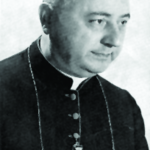
Annibale Bugnini
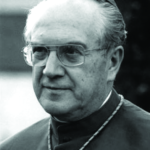
Sebastiano Baggio
Why do you think the dossier was stolen in the first place? [Editorial note: According to reports, Gagnon delivered the dossier, entitled “Nessun Dorma” (“No one sleeps”) to the Congregation for the Clergy offices on May 30, 1974. The Congregation was then headed by the American, John Joseph Wright. The dossier was handed over to Monsignor Istvan Mester for safekeeping. On the morning of June 2, 1974, Mester “opened the door to this room and found books scattered on the floor, papers in disarray, and boxes opened…” The lock on the chest in which the dossier had been placed on May 30 “had been ripped off.” L’Osservatore Romano reported: “It is a case of true and shameful robbery. Unknown thieves entered the office of a prelate and stole files from a solid chest with a double lock. This is a true scandal.” Although Gagnon was told not to write a new report, he “secretly put together a replacement for the stolen one.” That new report was finally brought to Pope Paul VI just weeks before the latter’s death in 1978.
MURR: That’s simple. The results of Gagnon’s investigation contained damning evidence against several major figures in the Roman Curia; Cardinal Sebastiano Baggio of the Sacred Congregation for Bishops and Bishop Paul Marcinkus, President of the (so-called) Vatican Bank, to name but two of the more infamous. There were any number of people who wanted to see if the dossier contained information detrimental to their persons and/or their “all-important” careers.
Was the dossier preserved or does its theft mean that it was permanently lost?
MURR: Archbishop Gagnon knew to make a duplicate copy for himself. He was of the opinion that those who attempted to steal the dossier wanted to know its contents and so empower themselves with information they could use to blackmail political enemies and further their own pathetic careers — not necessarily to destroy it.
Would you say then that people feared Gagnon?
MURR: In Rome, in those times, whenever Edouard Gagnon’s name was mentioned (where two or more were gathered), invariably someone would add: “The two who know all; the Holy Ghost and Edouard Gagnon!” In answer to your question: yes, Cardinal Gagnon was feared — by those who had reason to fear him; those guilty of grave misconduct. He was respected and admired by those who had no reason to fear him.
“… ARCHBISHOP BUGNINI (WHO, AMONG OTHER MISDEEDS, REDESIGNED THE CATHOLIC MASS) AND CARDINAL BAGGIO (WHO, AMONG HIS OTHER MISDEEDS, RECONSTRUCTED, OR SHOULD I SAY ‘DECONSTRUCTED,’ NEARLY THE ENTIRE CATHOLIC EPISCOPACY) COULD BE FREEMASONS”
You have spoken highly of Msgr. Mario Marini. He worked at the Secretariat of State as well as the Pontifical Commission Ecclesia Dei. Some Vatican documents bear his name as Undersecretary. The Archbishop of Seattle, Paul D. Etienne, was friends with him. He also wrote a book with meditations about Jesus with a foreword by Cardinal Marc Ouellet. Could you tell us more about Msgr. Marini?
MURR: To call Mario Marini “extraordinary” would be a tremendous understatement. Personally speaking, Mario was the man who had the greatest impact on my life. Fourteen years my senior, he was strong-willed but patient, knowledgeable on almost any subject, and good-humored. He was a man’s man; toughened by what life threw his way. His mother and father, and even his grandparents, were committed Marxists and, as such, extremely anticlerical. The day he completed his doctorate in civil engineering, he informed his parents that the following morning he would be leaving for the seminary in Milan. His mother slapped him hard across the face and shouted at him: “Better a whore for a daughter than a priest for a son!” When he was ordained and offered his first Mass in Ravenna, the church was only a stone’s throw from the Marini family home but his parents did not attend. Mario Marini knew the cost of loving Christ and His Church.
Once inside the Vatican, Mario never looked for personal fame. I cannot emphasize enough how different this made him from the majority of those who make up the Roman Curia. He remained faithful to God, to his calling, to the Church and to the Pope, and was happy in his role as one of the “powers behind the throne.” You never found him at a papal ceremony, at any public affairs of State or Church, or in any too public place. He worked tirelessly and very quietly for the good of the Church. He was a great friend and confidant of many cardinals, but Giovanni Cardinal Benelli was the man he most admired. Benelli was my mentor’s mentor.
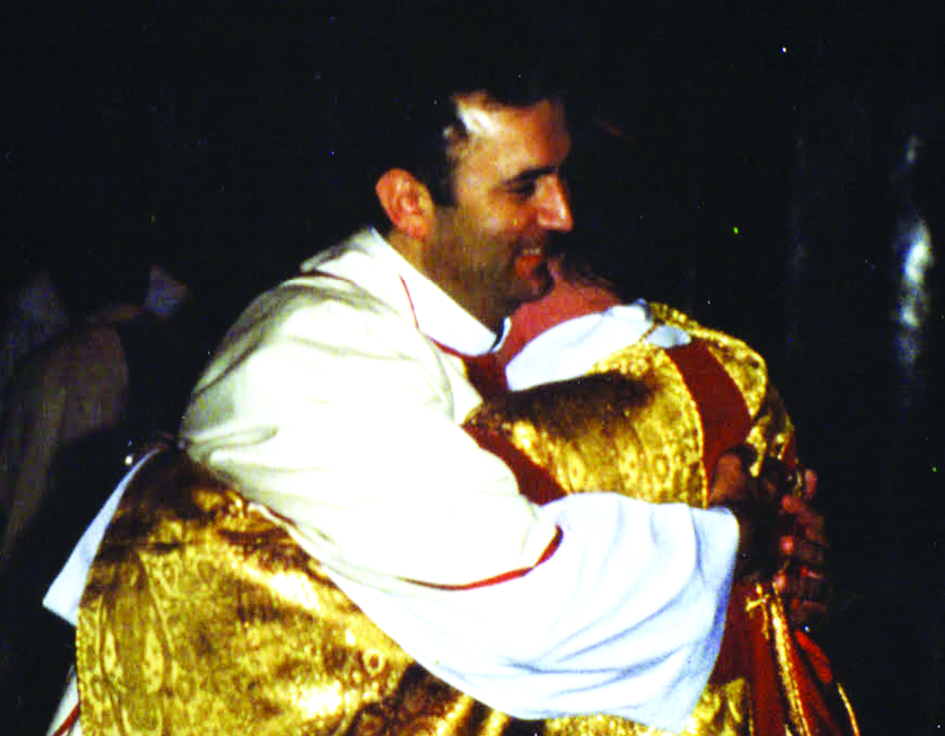
Fr. Murr’s ordination day with Marini
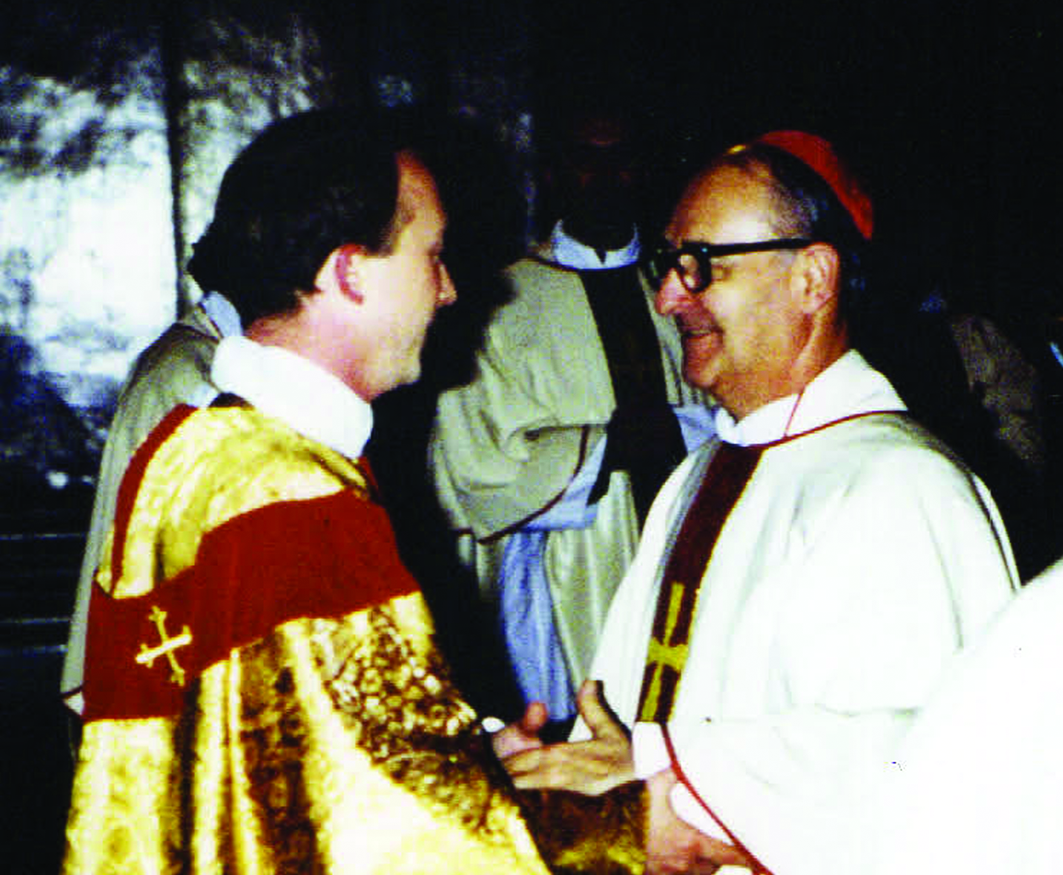
Fr. Murr’s ordination day with Gagnon
Can you tell us how Msgr. Mario Marini came to work for the Holy See?
MURR: While Cardinal Montini was Archbishop of Milan (1954-1963), he paid for Mario’s seminary training given the Marini family’s blatant anticlericalism. Later, in 1963, when Montini became Pope [Paul VI], he invited Marini to work for him in the Secretariat of State. John Paul II (1978-2005) admired him and sought his opinion on many important matters. Pope Benedict XVI (2005-2013) counted on him for counsel and support. In fact, since many who read this interview probably share your interest in matters liturgical, let me share a story that Marini shared with me shortly before his death. He had just been named Secretary for the Sacred Congregation for Worship and the Sacraments when Pope Benedict congratulated him personally and told the man who held a doctorate in civil engineering before entering the Milan Seminary and who later took a second doctorate in Sacred Theology, that it was refreshing to know that no professional liturgists were among the Divine Worship department heads. The pontiff felt greatly relieved that he could now speak and deal rationally with all involved. I am reminded of the old joke about the difference between a liturgist and a terrorist: you can negotiate with a terrorist! Evidently, Pope Benedict felt the same way.
What became of your friendship with Marini?
MURR: In 1985, Mario and I had a falling out and didn’t really communicate for years. I detailed the story of what happened between us in my book The Society of Judas.7 Though Mario and I reconciled when I suffered a heart attack in Rome (2005)8 — imagine, from a hospital bed in the Policlinico Gemelli, opening your eyes to see the man who called you to priesthood standing at your side, administering the last rites! — I was shocked when in March of 2009, I received a sort of “out-of-the-blue” phone call from him and listened to his apology. He asked me to come to Rome so that we could speak in person and really renew our friendship. I readily agreed, of course… I had no idea that would be the last time we would speak on this side of the divide.
There are reports that Marini died a couple of months later. In its obituary, the blog Rorate Caeli referred to Marini as a “true friend of Tradition.”9 Can you tell us anything about his death?
MURR: As soon as I learned of Mario’s death, I contacted a mutual friend of ours at the Congregation for the Doctrine of the Faith [CDF]. He confirmed the news and explained that the cause of death was cancer of the liver. It seems Mario told no one just how serious his condition was.
Your book The Godmother centers on the story of true Christian friendship. This theme shines through very clearly with respect to your relationship with Mother Pasqualina. What would you say of its application to your relationship with Gagnon and Marini?
MURR: Well, almost immediately, Marini, Gagnon and I became friends. The mutual spark of “simpatico,” was there. Each of us loved Christ Jesus, possessed an integral and orthodox Catholic faith, and had a special love for Christ’s Bride and our mother, the Church. We were also keenly aware that the present state of that Church was somewhere between lamentable and alarming.
The Godmother also references how some people would be more attracted to the more “sensational” elements in the book. What would you say to those people who are interested only in the “sensational” aspects of your book?
MURR: While the “sensational” can certainly grab and hold your attention, it has no real, no substantial saving graces. Amicitia [friendship] is saving grace. It is precisely what God calls us to when He tells us through His Son: “Vos autem dixi amicos” [“I have called you friends”].
For the sake of clarity, I would like to turn to some of those more sensational revelations. As the likely last-living associate of Gagnon from the time of his Visitation, your testimony regarding the evidence that Archbishop Annibale Bugnini was a Freemason is as provocative as it is authoritative. Were you aware of the impact your testimony might have upon the Catholic world, especially to liturgical scholars?
MURR: Well, yes and no. At the risk of sounding cynical, I don’t expect to change the mind of anyone who finds it too conspiratorial to consider that someone like Archbishop Bugnini (who, among other misdeeds, redesigned the Catholic Mass) or Cardinal Baggio (who, among his other misdeeds reconstructed, or should I say “deconstructed,” nearly the entire Catholic episcopacy) could be a Freemason. Nor do I expect the average man to believe that Propaganda Due, the organization that set out to destroy the Vatican’s financial base and bring Catholicism’s central government to her knees, was a lodge of Italian Freemasons. Nonetheless, I do find it rather compelling that each Freemason involved in this dastardly plot was found guilty by the Italian courts and ended up murdered, committed suicide, or died in prison. To a great degree, I sympathize with those who don’t, who can’t, believe such things. For twenty-seven years, I numbered among them.
Furthermore, given the modernist chaos presently rampant within the Roman Catholic Church, even if the majority of liturgical scholars, theologians, philosophers and, as you say, “the larger Catholic world” would come to see, beyond the shadow of a doubt, that men like Bugnini and Baggio were high-ranking Freemasons, I doubt it would bother them in the least.
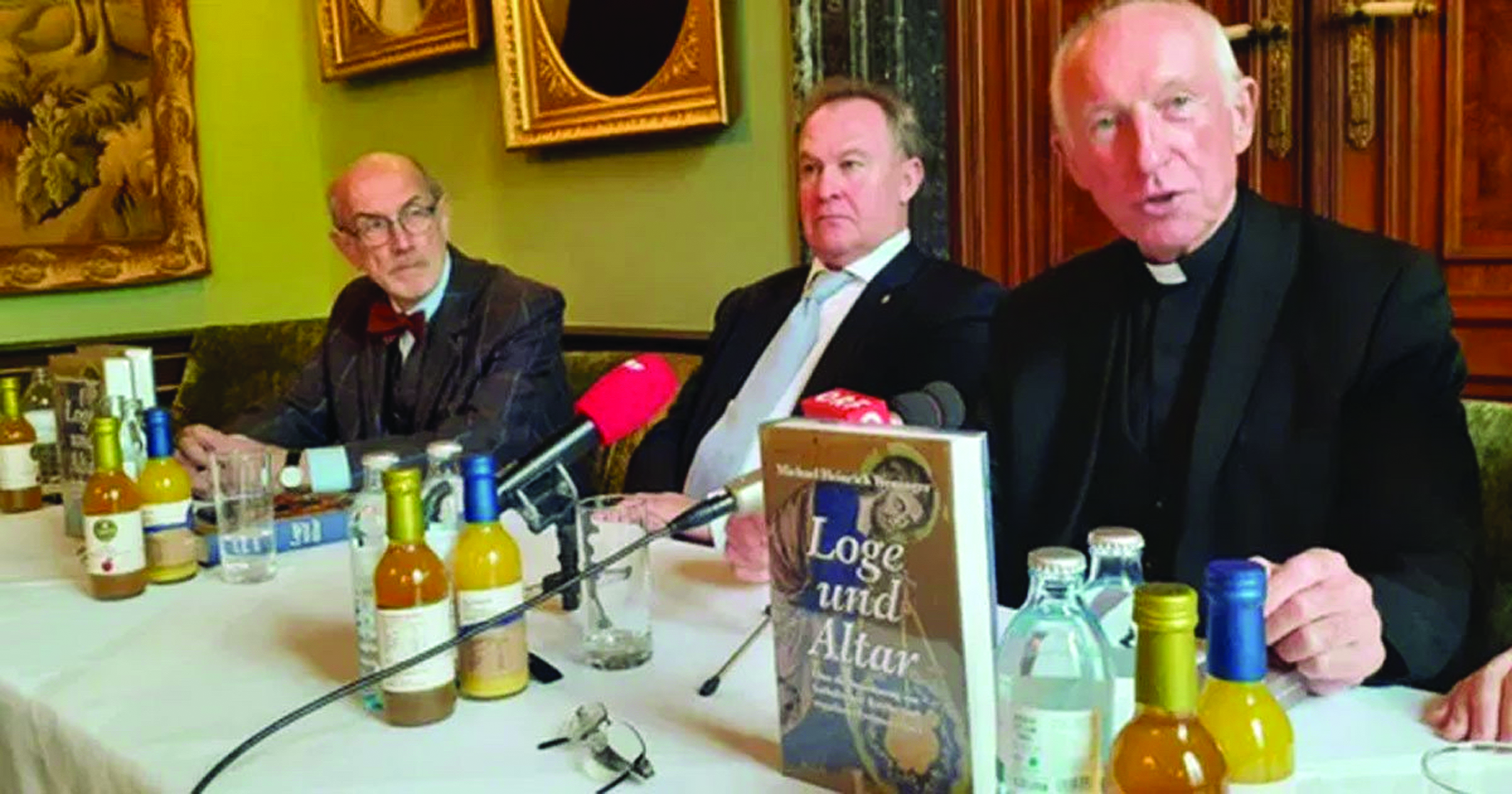
Monsignor Michael Heinrich Weninger, chaplain to three Masonic Lodges in Austria, author of Lodge and Altar: On The Reconciliation of the Catholic Church and Regular Freemasonry
“… WHILE MANY MAY NOT BE ABLE TO ACCEPT BUGNINI’S MASONIC KINSHIP, HOW CAN ANYONE NOT ACCEPT THE MASONIC RESULTS OF HIS LABORS?”
Why do you believe the majority would not be bothered?
MURR: Because from 1965 to the present, the majority of Catholics — and by “majority” I mean the majority of the minority who haven’t already left the Church — faithfully followed their priests and bishops who, themselves, happily followed — some of them even surpassed — Archbishop Bugnini. The result is that the “majority of that Catholic minority” are, for all intents and purposes, the third Protestantized generation of Catholics. One wonders the degree of delight it would have given Bishop Bugnini to see the practical results of his new Mass. Besides, I just learned — and this is public knowledge — that Papa Bergoglio appointed a priest and a Freemason to a Vatican position. Monsignor Michael Heinrich Weninger, chaplain to three Masonic Lodges in Austria, is a member of the Pontifical Commission for Interreligious Dialogue.10 Monsignor Weninger is also the author of Lodge and Altar: On The Reconciliation of the Catholic Church and Regular Freemasonry.11 Therefore, why would it be hard to believe that the likes of Bugnini and Baggio helped pave the way for him and others so free-thinkingly inclined? God help us!
Indeed, one has to wonder how Weninger could believe himself safe to declare openly his membership in Freemasonry. So, what do you believe are the “practical results” of Bugnini’s work?
MURR: Sadly, I refer to the “Mass as sacrifice” being replaced by the “Mass as get-together.” This, of course, and tragically, results in the appalling lack of belief in the True Presence of Jesus Christ, Body, Blood, Soul and Divinity, and the lack of reverence for the Mass and Blessed Sacrament, and the watered-down importance of the seven Sacraments in general. While many may not be able to accept Bugnini’s Masonic kinship, how can anyone not accept the Masonic results of his labors? “Igitur ex fructibus eorum cognoscetis eos” [“By their fruits therefore you shall know them”], the Lord reminds us. If Bugnini’s liturgical reform — in particular that most sacred mystery of our Catholic Faith, the Holy Sacrifice of the Mass — does not loudly and clearly cry out: “Liberté, Egalité, Fraternité,” then what does it cry out?!
In The Godmother, you make reference in Chapter 19 that the idea to “promote” Archbishop Annibale Bugnini to Pro-Nuncio to Iran was Msgr. Marini’s idea. Is this accurate and if so, could you elaborate?
MURR: Perhaps it would be better to say that Marini made a major contribution to the planning and execution of the idea. Mario understood better than most the age-old “promoveatur et amoveatur” [“let him be promoted so as to be removed” — promote someone to get rid of him] concept. The Vatican actually raised this adage to an art form.
In fact, Marini, my friend, never accepted a promotion to bishop — which was offered to him, twice and personally, by his mortal enemy Sebastiano Cardinal Baggio, in the frantic hope of getting rid of him for good! At any rate, Mario, Giovanni Benelli’s right-hand man in such things, had to wait not only for the correct opening for Bugnini to fill (i.e., to be exiled to), but also to make sure the one or two Bugnini supporters on the planning commission would be absent from the meeting that decided Bugnini’s fate. I’m not sure whether it was the [1976] Annibale Bugnini “promotion” to Nuncio to Iran or the [1977] Mario Pio Gaspari “promotion” from Apostolic Delegate to Mexico to Nuncio to Japan, perhaps it was in both cases, since both men were Cardinal Baggio protegés — but for the planned promotion to succeed, Cardinal Baggio had to be absent from the committee meeting in the secretariat or he would have blocked the promotion(s). In one of the cases, I remember that Baggio had to be sent (by order of the Secretariat of State) to represent the Holy See at some historical commemoration event in Northern Italy, so that he would be absent from the afternoon secretariat meeting and the “promotional” vote would be successful. This and other such tactics were how Marini (and the Benelli Boys) got around Freemasonic attempts at blocking progress. “Fight fire with fire,” Mario liked to say.
The revelation about Bugnini being involved with the Freemasons casts a non-negligible shadow on the liturgical reforms, as we talked about in our previous interview. The obvious question arises: “Where do we go from here?”
MURR: There are differing ways to look at this question. Some people have proposed a quick and simple solution: Bugnini’s membership in Freemasonry means we should hit the reset button on everything that happened from the publication of Sacrosanctum Concilium to the present. True, as a Freemason, Bugnini would be persona non grata to many people, dare I say a reprobate and a prime candidate to be excommunicado, and there is reason to question his authority. The problem here is that Paul VI lent his authority to the changes—a fact that Bugnini was rather keen to emphasize in his book The Reform of the Liturgy (1948-1975).12 Thus, papal authority is bound up with this question and we have to be mindful of that.
Another idea presently circulating is that Bugnini’s “reforms” extend back to the Pian Holy Week reforms of the mid-1950s. Therefore, those reforms are similarly under scrutiny. This belief is mistaken. Mother Pasqualina herself refuted the idea that it was Bugnini who “masterminded” those particular reforms. I spoke about this in Chapters 15 and 21 of The Godmother. In short, her answer was that those reforms were all the Holy Father’s [Pius XII] doing. She emphatically denounced Bugnini taking credit for them.
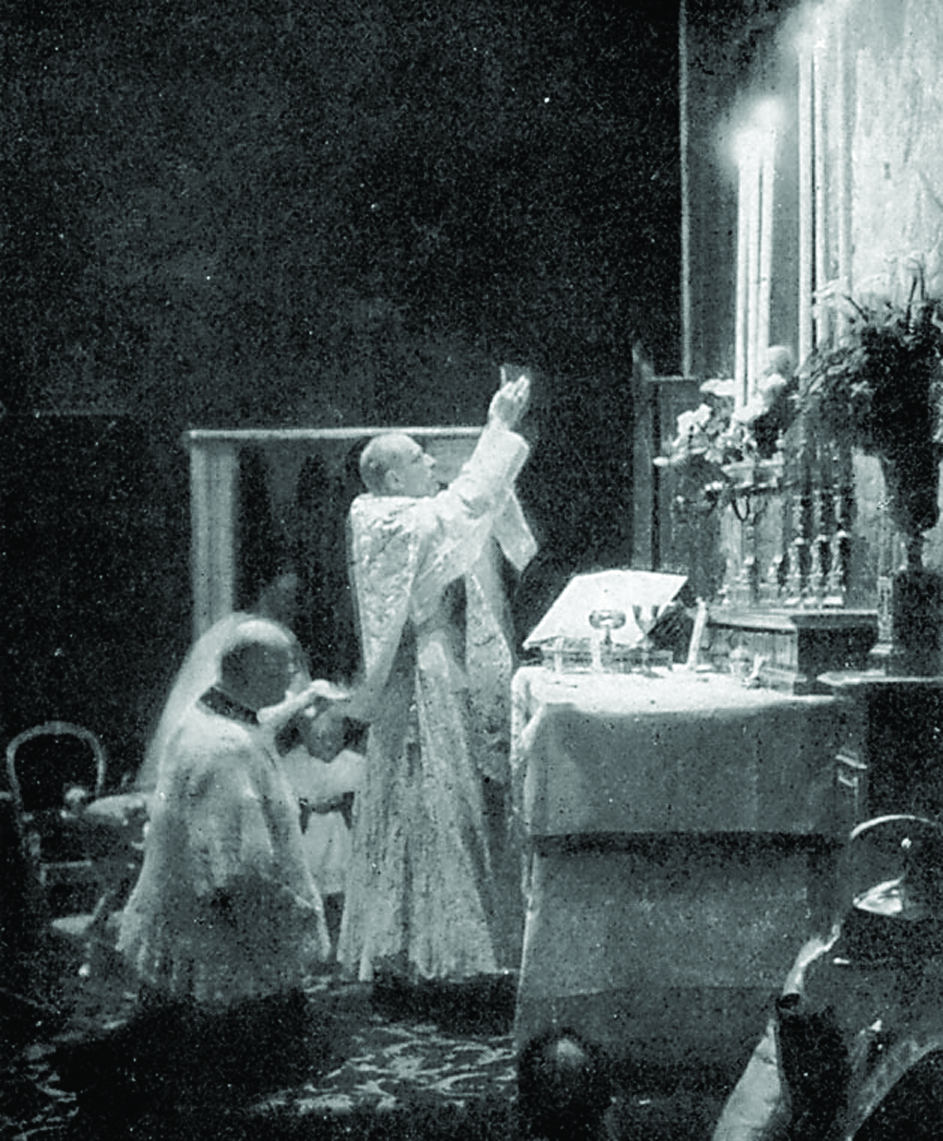
Pius XII during a celebration of Holy Mass

Archbishop Carlo Maria Viganò, who has called for a new assessment of Vatican II
What, then, do you believe should happen with the Latin liturgy?
MURR: In its present lamentable state, the Latin liturgy cries out to be restored. I am no great authority on matters liturgical; however, since you ask my opinion, let me repeat what Sister Pascalina Lehnert told me c. 1975. While Pope Pius XII was working on his plans for a Second Vatican Council — studies, investigations and schemas that, ultimately, he felt obliged to abandon since he came to the conclusion that the world’s bishops “lacked the maturity to bring it [the Council] to fruition” — he actually considered approving vernacular translations in certain parts of the Mass. As I understood it, the Holy Father considered allowing the Scripture readings at Mass and the Mass Propers — in other words, the “variables” of the Mass — to be proclaimed and prayed in the vernacular. The Ordinary of the Mass — that is, the unchangeable parts of the Mass (i.e., the Prayers at the Foot of the Altar, the Offertory, and above all else, the Roman Canon, etc.) — would remain untouched and in the official, ancient and unifying language of the Western Church: Latin.
From the moment Mother Pascalina shared this, it seemed obvious to me that these were all the modifications that might have helped the Holy Sacrifice of the Mass to be better understood and appreciated by modern men and women. Of course, turning the priest around to face the congregants and give his back to God, was so absurd as to never have been considered.
Such simple modifications would have required no wrecking crews smashing our altars to smithereens, demolishing our sanctuaries, hauling away dumpsters filled with sacred reliquaries and statuary. They would not have required senseless liturgical committees producing endless opinions on matters on which they had no right to opine, no Eucharistic sacrileges clamoring to heaven for vengeance, no blasphemies and no heresies. The Holy Sacrifice of the Mass would have been preserved intact as, God willing, one day soon again, it shall be.
Simply put: what “Bugnini & Brothers Wrecking Company” did to our Mass and Sacraments was far more than disrespectful, disgraceful and inorganically conceived. It was anti-Catholic to the core.
In 2005, the liturgical scholar Dom Alcuin Reid published a book about the organic development of the Liturgy. Why is this organic nature of the Liturgy an important consideration?
MURR: Because that is how, after 2,000 years, we came to receive the Mass and the Sacraments from their very liturgical beginnings. Pope Benedict XVI, as Cardinal Ratzinger, began to address this problem in his book The Spirit of the Liturgy and, step by little step, throughout his later pontificate.
Others have posited that we ought to look at what the Council Fathers actually intended to do with the reforms as stated in Sacrosanctum Concilium. What would you say to this idea?

Paul VI with Virgilio Cardinal Noè, former papal master of ceremonies
“NO DOUBT POPE PAUL’S ‘SMOKE OF SATAN’ REMARK (1972) INCLUDED LITURGICAL ABUSES”
MURR: Well, since most of the Council Fathers are no longer with us, to look at what they “actually intended” to do with the reforms (as stated in Sacrosanctum Concilium) would be to risk yet other misinterpretations, would it not? We might look instead to Archbishop Carlo Viganò and his suggestion that we reconsider the “non-dogmatic” Second Vatican Council. When I first read Archbishop Vigano’s statement that the Council, in essence, be declared a “mis-Council,” my eyes widened in surprise — about as much as they did when I first read Pope Benedict XVI’s claim that the (Tridentine) Latin Mass had never been abolished or forbidden to be offered, as I distinctly remember it being otherwise.
Don’t get me wrong: I don’t completely disagree with Archbishop Vigano, I was just very surprised by the forwardness of his suggestion. Many a Churchman (high and low) has been thinking such thoughts — some for more than 50 years — but no one dared speak it aloud until Carlo Maria Viganò pronounced it recently! Truly incredible. The man is fearless; a miraculous breath of fresh air! You’ve got to love him! I believe, however, that now, with more than half a century passed since the conclusion of the Second Vatican Council, it is time to reconsider the entire matter, calmly, intelligently, patiently.
I’m smiling, remembering Cardinal Gagnon’s personal rebuff when, only half-jokingly, I suggested that a “Vatican III” be convoked to figure out and deal with Vatican II! “Bah!” the cardinal huffed, “and give those scoundrels a second chance at destroying what they failed to destroy the first time? God forbid! Never!”
In other words, let the Council speak for itself, without interpreters on every side of every issue?
MURR: In Rome, in the aftermath of Vatican II, there was much renewed enthusiasm for Sacred Scripture. The Biblicum was the place to begin your studies (if you had the brains and talents it took to be admitted), and Jerusalem (L’École Biblique) was where you wanted to end up. This “renewed interest” in Sacred Scripture was heavily influenced by modern Protestant advances in (ancient) linguistic studies, archaeology, hermeneutics and the like. It seemed that everyone and his second-cousin were studying, or planning to study, German.
To many, the liturgy itself — especially the Mass — stood in dire need of much more Scripture, much less systematic theology, and absolutely no philosophy! In those days, the mention of St. Thomas Aquinas got about the same reaction as mentioning the devil himself! How insane things become when logic is thrown out the window! What’s more, as anyone who could see, the Catholic Mass, from beginning to end, is Sacred Scripture!
Virgilio Cardinal Noè, Paul VI’s former papal master of ceremonies, said in 2008 that Pope St. Paul VI’s statement about the “smoke of Satan” entering the Church pertained to abuses with the liturgy.14 This claim indicates that Paul VI was concerned with liturgical abuses after the Council had ended. Why, then, would he not have followed through with such a concern after learning about Bugnini?
MURR: While no doubt Pope Paul’s “smoke of Satan” remark included liturgical abuses — the Vatican was being inundated with reports of the most outlandish, sacrilegious and even blasphemous liturgical abuses from all around the world — Msgr. Noè’s answer seems suspiciously self-serving.
How “self-serving”?
By 1972, tens of thousands of priests were “hanging up the cassock,” hundreds of thousands of nuns had abandoned their apostolates and then their vows — by 1975 that number had grown to half a million ex-nuns. Catholic theologians and seminary and college professors were openly critical of the Magisterium and of the Pope himself, particularly of his 1968 encyclical, Humanae Vitae. In other words, the billowing over-abundance of smoke could hardly be limited to liturgical abuses. The Church was dealing with actual apostasy, as defined by St. Thomas Aquinas in the Summa Theologiae.15 Besides, from the time Virgilio Noè became undersecretary of the Congregation for Divine Worship in 1975, and then, in 1982, became secretary of the same, liturgical abuses did not diminish; in fact, many in the Roman Curia accused Noè himself of encouraging some of them.
Are you at liberty to mention any names of Noè’s accusers?
MURR: It was being said by quite a few men I knew in the Curia that there seemed little (if any) difference between Noè and the “dearly departed” Bugnini. Ed Petty (later, Msgr. Petty) and I were two of Noè’sfavorite acolytes for papal ceremonies in the mid-1970s. In May of 1977, Noè also showed up at my ordination — just to see who was there. I talked about this in Chapter 29 of The Godmother. Noè’s ready answer to anything he himself did not like or want done was always the same: “Il Santo Padre non piace” [“The Holy Father doesn’t like it”]. He hid behind Pope Paul VI — avoided taking personal responsibility for his decisions.
However, when Pope John Paul II came along, and paid Noè no heed (almost pushing him out of his way on occasion) and went to mingle with the crowds after different liturgical events, many a priest, bishop and cardinal nodded and smiled in agreement with the new papal attitude toward the master of ceremonies.
Speaking of Paul VI, let us return to the topic of Archbishop Gagnon and the Apostolic Visitation that he conducted. What happened when he presented the dossier to the Holy Father?
MURR: When Archbishop Gagnon presented Pope Paul VI with the final report of his three-year investigation, the Pope pushed the results off to one side of his desk and told Gagnon that he simply wasn’t up to reading it; that he would leave it and its execution to his successor. Paul VI died some 50 days later (on August 6, 1978).
Why would Paul VI treat the results in such a manner when it was he who had commissioned it in the first place?
MURR: Age. Fatigue. Weariness. Feebleness. Anxiety over the proximity of death. Perhaps the profound disillusionment of having started a pontificate with so much hope and ending it in such a state of despair. Of course, I’m playing the psychologist here — only guessing at what might have motivated him… still, I think it’s a rather educated guess. Gagnon saw it this way, as well. Naturally the archbishop was unhappy with the papal response — but he understood the Pope, all the same.
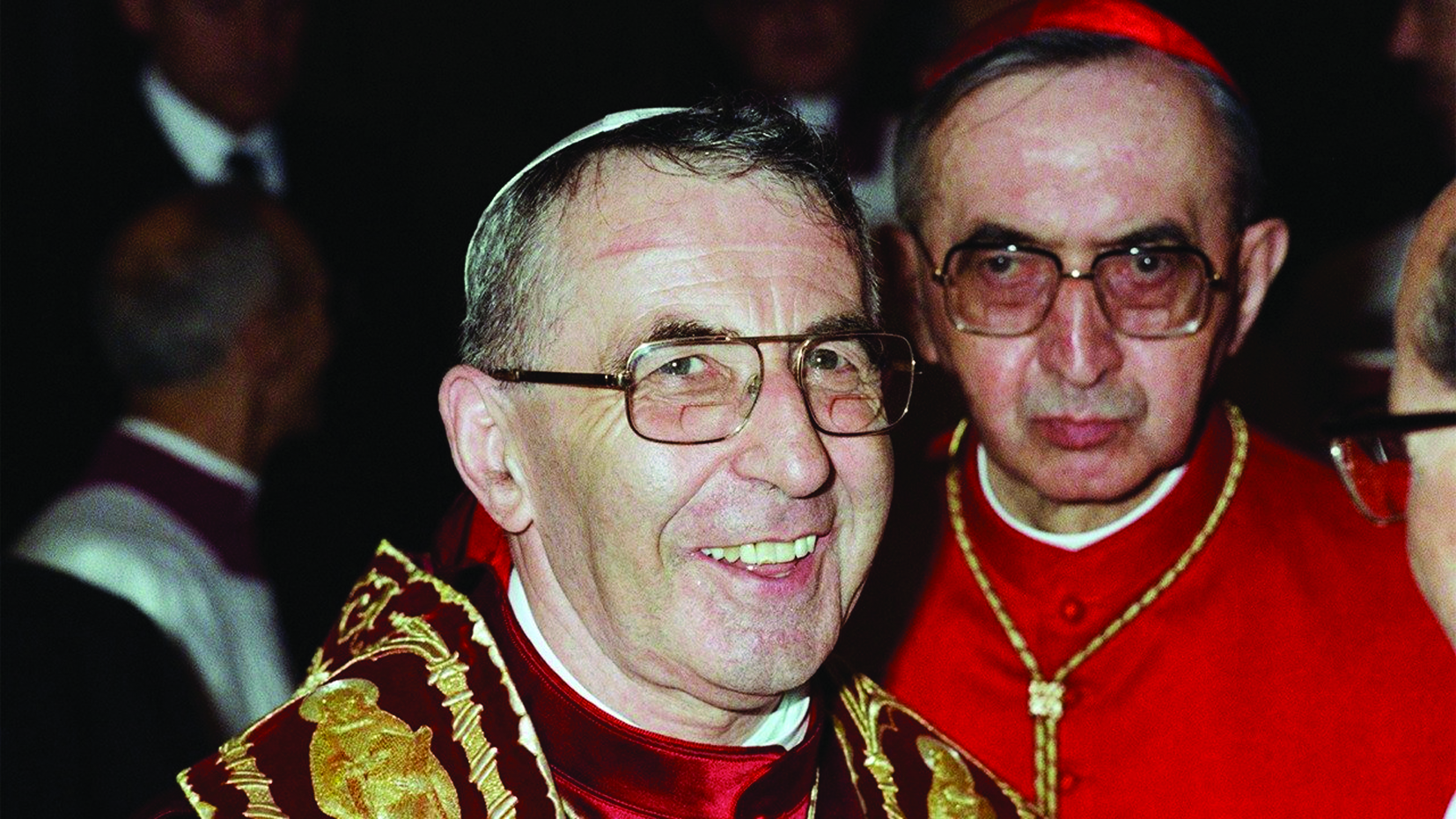
John Paul on the day of his 1978 election, with Paul VI’s Secretary of State, Jean Cardinal Villot, later confirmed by the new Pope
Paul VI died and Papa Luciani [John Paul I] was elected to succeed him. The short-lived pontificate of John Paul I is well-known. Was Gagnon able to present the report to the new Holy Father? If so, what can you tell us of this event?
MURR: Within days of Luciani’s election to the See of Peter, Archbishop Gagnon was summoned to a private audience with him. This meeting was at Cardinal Benelli’s insistence with the new Pope. John Paul I had already decided to rid himself of Paul VI’s Secretary of State, Jean Cardinal Villot, and replace him with Giovanni Cardinal Benelli. Most unfortunately for the new Pope, his timing was off. The correct moment to have made that major change in government was toward the end of the Conclave that elected him; right after receiving obeisance from each of his electors. That would have been the perfect time for the new pontiff to have summoned four burly Swiss Guards and ordered them to escort the former Secretary of State back to France. However, Pope John Paul I — a total outsider when it came to understanding and dealing with the Roman Curia — rather than present Giovanni Cardinal Benelli as his new Secretary of State, his “right-hand man,” actually reinstated, “for the time being,” every member of the Roman Curia in his post! A fatal mistake.
Why was it a “fatal mistake?” What was so bad about Villot?
MURR: Throughout the 1970s, there were voices in the loggia whispering that Jean Villot was a French Freemason. For the record, however, no such thing was ever proven—and by “proven” I mean that, to the best of my knowledge, no concrete evidence ever confirmed this. The whispers remain just rumors. That said, Jean Cardinal Villot was an ally and supporter of Sebastiano Cardinal Baggio. (In the 1978 papal election, Villot lent his full support to Baggio. “Qui se ressemble s’assemble” [“Birds of a feather flock together”], as the French say. BothVillot and Baggio were well-established enemies of Giovanni Cardinal Benelli. Thus, when the newly-elected Pope John Paul I confirmed Villot as his Secretary of State, “for the time being,” this was a grave mistake.
Remember Friday, January 20, 2017? The President of the United States, Donald Trump, has just been sworn into office. Imagine, if you can, Donald JohnTrump turning to Hillary Rodham Clinton and, in front of God and the whole world, asking her to continue on as his Secretary of State — “for the time being.” Hard to imagine, you say? Do I hear, “Impossible”? Well, essentially, that is what Papa Luciani did upon his election as Pope!
Fair enough. How then did the meeting go between Gagnon and John Paul I?
MURR: Gagnon met with the new pontiff, Pope John Paul I, and — as advised by Benelli (as if he needed advising) — Gagnon took with him the completed study of his investigation and a much-redacted dossier thereof. That redacted version consisted of several typewritten pages of urgently needed changes in the Roman Curia; some long overdue transfers, and some new, strongly suggested appointments. Gagnon left the papal audience completely satisfied. “He will act quickly,” he told me. I can still see his face; there was no smile on it; rather, after making that matter-of-fact statement, he concluded with the word: “Done.” His expression was stonelike, serious. After three years of intense and challenging work, dangerous interviews, room and office break-ins and physical threats to his life, Edouard Gagnon had accomplished what by papal decree he had been commissioned to do. Change, much and desperately needed change was about to come to the Church, to the People of God — like rain to a parched earth.
So there was some hope and enthusiasm over what was to result from the Visitation report under the new Holy Father?
MURR: To be sure. Later that night, the three of us [Gagnon, Marini and I] went to dinner at Lo Scarpone [“The Big Shoe”] and, as always, we took our far-in-the-corner table where we could speak more freely. Marini was elated with Edouard Gagnon’s description of the papal briefing on the Visitation — that is, with what Gagnon felt he was able to share. And though Gagnon did not come right out and say it, we knew that Giovanni Benelli was on his way back from Florence to Rome to take control of the Secretariat of State. Personally speaking, I felt that the years of uncertainty [1965-1978] were over. There would finally be a straightforward, Catholic direction in the Church. John Paul I and Benelli might even become a second Sarto/Merry-del-Val team!
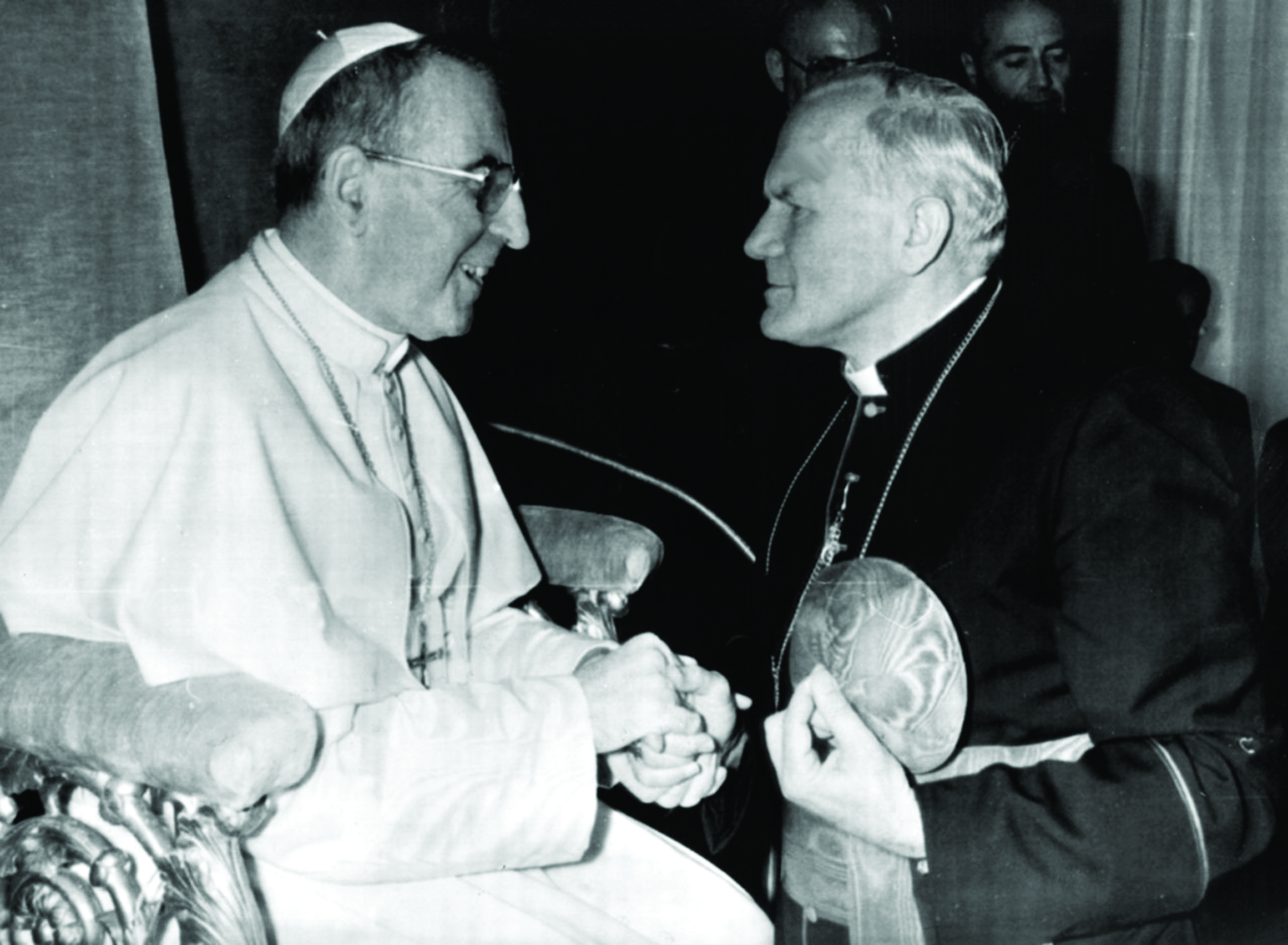
The newly-elected John Paul I receives the congratulations of Archbishop Karol Wojtyla (a month later, Pope John Paul II).
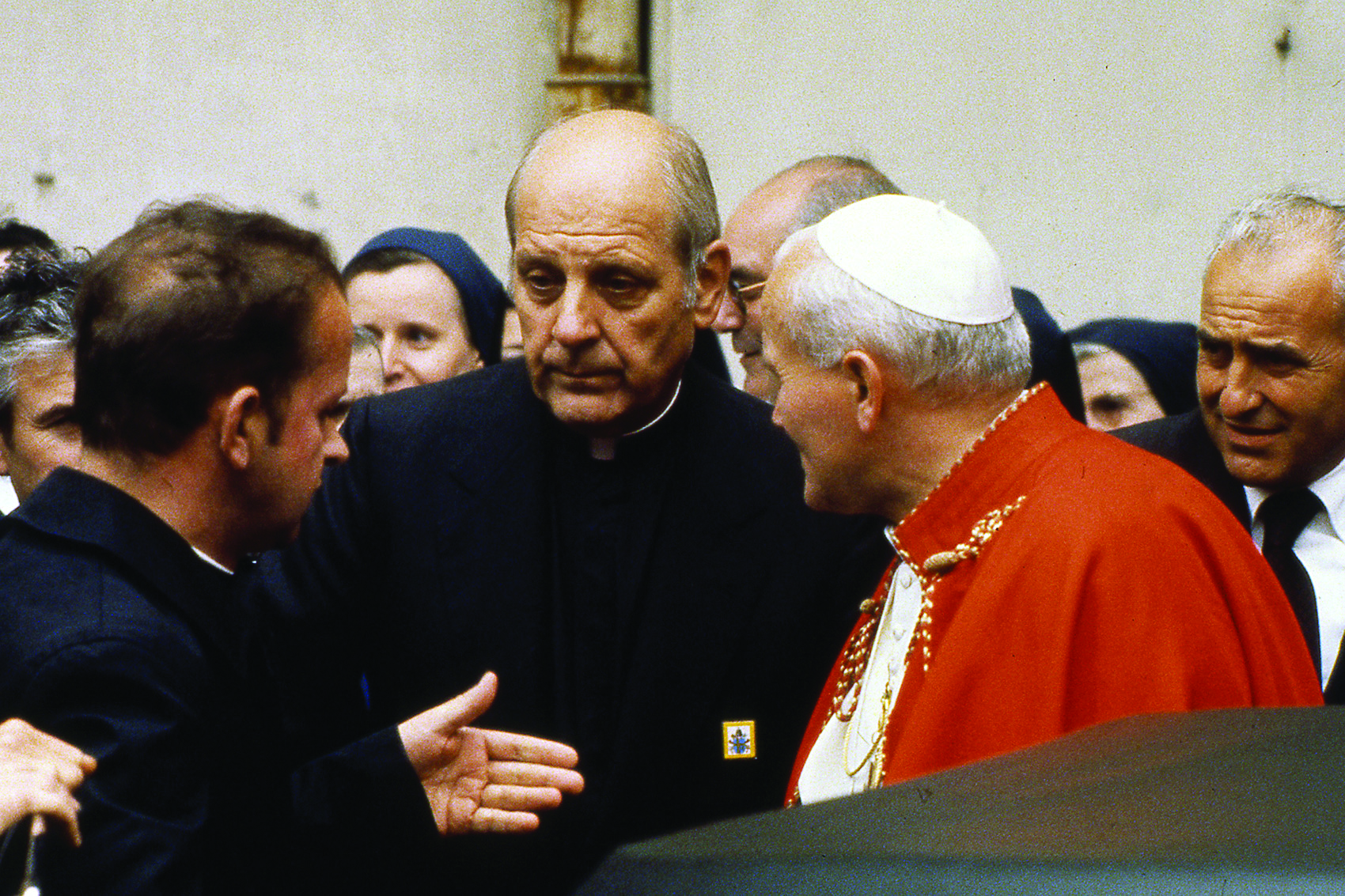
Archbishop Paul Marcinkus, between Pope John Paul II and his private secretary, Msgr. Stanislaw Dziwisz
But it wasn’t meant to be. Pope John Paul I died shortly after his election…He was succeeded by Karol Wojtyla, Pope St. John Paul II. Did Gagnon also speak with John Paul II about the report? If so, what happened?
MURR: Indeed, Gagnon did speak with Pope John Paul II. Pope John Paul II summoned Archbishop Gagnon to a private audience in October 1978 to discuss the results of the Papal Visitation to the Roman Curia. In that October meeting, Archbishop Gagnon detected much less enthusiasm on the part of the new pontiff. John Paul II was already preparing to travel. To Mexico, if I’m not mistaken. And, like his rather imprudent, very short-lived predecessor, the new Pope also reconfirmed every member of the Roman Curia in his position — first and foremost, the Secretary of State, Jean Cardinal Villot. Suffice it to say, reforming the Roman Curia was the furthest thing from the Polish Pope’s mind.
How exactly did Gagnon advise John Paul II to act?
MURR: Based on the results of his investigation, Gagnon urgently insisted that the Pope: 1) remove Sebastian Cardinal Baggio from his position as Prefect for the Sacred Congregation for Bishops and replace him with a strong and believing Catholic who would give the Catholic Church the good bishops she so urgently required, 2) remove and replace Cardinal Jean Villot as Secretary of State, 3) remove and replace Bishop Paul Marcinkus as President of the Instituto per le Opere di Religione [i.e., the Vatican Bank].
Gagnon warned him that if drastic measures were not taken to reform the Church’s central government, he, the Pope, would be responsible and would greatly suffer the consequences.
Gagnon relayed this stern warning to the Pope, “Not to act swiftly and decisively, Holy Father, will cause much more harm to the Church — and could cost you your life, as well.”
Given how the events of the Holy Father’s life later played out with the 1981 assassination attempt, that last warning is especially grave. What was John Paul II’s response to these warnings and recommendations in 1978?
MURR: He did not disagree with the recommendations, but he did not see the urgency of implementing them so soon. Besides, the new Pope had already decided on a new direction, a new role for the papacy. He himself, the Vicar of Christ on earth, would carry Christ’s Gospel to the ends of the earth, to a world much in need of the Good News. This was Pope John Paul II’s goal; not the reform of the Church’s government. Naturally, every member of the Roman Curia — above all, Jean Villot, Sebastiano Baggio and Paul Marcinkus — was elated with the Polish Pope’s fresh evangelical ideals! Practically every member of the Roman Curia applauded the announcement of every new trip! And, of course, the mice played and played while the cat remained away, and further and further away!
With someone like Baggio selecting the bishops, would you think it fair to say that there were some questionable characters put into positions of authority?
MURR: You’d be very safe in assuming more than a few “questionable characters” made it to positions of ecclesiatical authority, back then. And remember: they are bishops for life. As Marini used to remind:
“Whether heaven or hell be their final destination, they will be in heaven or hell, for all eternity, as bishops.”
How did Gagnon respond to the Holy Father’s reaction?
MURR: Let me start by saying that Archbishop Edouard Gagnon was a scholar and a saint; a lawyer, a theologian, a practical and no-nonsense man and, most importantly, nobody’s fool. The morning after Gagnon’s private audience with John Paul II, I accompanied him to Cortile San Damaso at the Vatican. Gagnon waited in the car and sent me upstairs to the Secretariat of State. I was to hand deliver his resignation from all things Vatican to the Pope, through his reconfirmed Secretary of State, Jean Cardinal Villot. To put it mildly, when Villot finished reading the short but not-so-sweet missive, he was outraged. One does not simply “resign” from a papal appointment in the Vatican; protocol forbade it; it was unheard of. Villot insisted that Gagnon present himself in the Secretariat immediately. I informed the Secretary of State that the archbishop would not, and bid him a good day. I returned to the car and drove Archbishop Gagnon straight to Leonardo Da Vinci Airport. He left Rome, intent on never returning. His fervent desire was to return to Colombia and—holy priest that he was — to recommence his work there among the poor.
Two and a half years later, May 13, 1981, was the assassination attempt on John Paul II’s life. Was this attempt connected to Gagnon’s warning to the Holy Father back in 1978? If so, what did John Paul II do now that Gagnon’s warning had come to pass?
MURR: Yes, it was connected to Gagnon’s warning to the Pope — and that certainly seems to be how the Pope himself took it. Mind you, I wasn’t there to hear this with my own two ears, but it was reported by many people in the know that from his Policlinco Gemelli hospital bed, when he regained consciousness, Pope John Paul II’s first words to his private secretary, Msgr. Stanislaw Dziwisz, were: “Find Gagnon.” The word went out and the search for Gagnon was on. It was Cardinal Casaroli who finally located Archbishop Gagnon and communicated the Holy Father’s express desire that he return to Rome at once and take up some very unsettled matters.
Except to say that Gagnon obeyed the Pope, returned to Rome and was made a cardinal, I don’t wish to comment any further on the matter. I will save that commentary and a few more surprising revelations for my upcoming novel, the working title of which is Of Rats And Men. I will say this much now: only after the May 13, 1981 assassination attempt did the Polish Pontiff call Giovanni Benelli to be his right-hand as Secretary of State. Benelli died of a massive heart attack two weeks prior to beginning that new job. Another Roman “mystery.”

Cardinal Baggio (left) with Cardinal Agostino Casaroli.

the attempted assassination of Pope John Paul II on May 13, 1981, in St. Peter’s Square. The Pope survived
Do you mean to imply that there was something suspicious about Benelli’s death?
MURR: I mean to say that I find it highly suspect for a healthy, 61-year-old, powerhouse of a man like Giovanni Cardinal Benelli to suddenly drop dead of a heart attack just days after agreeing to become Pope John Paul II’s new Vatican Secretary of State, and just days before actually tackling the tremendous challenge of restoring order in an out-of-control Church. I’m saying that I consider it highly suspect that that same man, Giovanni Cardinal Benelli — whose first and foremost piece of business as Secretary of State would most assuredly have been the unceremonious removal of Sebastian Cardinal Baggio from the Congregation for Bishops — should die before his first Roman day on the job.
You mentioned Paul Marcinkus earlier. He is sometimes referred to as the “unofficial bodyguard” of Paul VI who thwarted an assassination attempt on Paul VI’s life in Manila, Philippines in 1970. Later, Marcinkus was under indictment before Italy’s Supreme Court on financial charges. When the statute of limitations ran out, he showed up — leaving Vatican City. Did you know him?
MURR: Everyone I knew in Vatican circles considered Paul Marcinkus — how shall I put this? — not a man of extraordinary intellect. In fact, he was seen as the epitome of American naïveté. At the risk of sounding exaggerated, permit me to describe the brief 1975 meeting between Marcinkus and my dear avuncular friend, John S. Lloyd, CityAttorney of Miami, Florida. I accompanied Lloyd to Marcinkus’ office in the “Vatican Bank” and knocked on his half-opened office door. I could hear that the bishop bank-president was in the middle of a phone call; nonetheless, he called out a loud “Avanti!” for us to enter. When I opened the door fully he waved us in and pointed that we should take to the two chairs facing his desk. Marcinkus continued his English conversation. The big man was dressed in a black suit and Roman collar; his two feet crossed at the ankles and resting on the desktop; a lit cigar in his right hand. He was “Yankee Imperialism” incarnate. Frankly, I was embarrassed that John Lloyd, a convert to the Faith, had a front row center seat to such a ridiculous, cartoonish, bombastic display of crass Americana. I couldn’t get out of there fast enough.
Marcinkus was the Yankee fool whom the Italian Freemasons, with the greatest of ease and very little flattery, took for a ride. When it was finally discovered just how he had been played and utilized by Propaganda Due — the Freemasonic Lodge that orchestrated the Vatican Bank scandal — Marcinkus remained inside the Vatican walls to escape Italian prison walls. During his confinement, he lamented that, deprived of a golf course, his golf game was bound to suffer! The point is, Marcinkus was more foolish than evil. Villot and Baggio, who defended Marcinkus as president of the bank, knew much better than he what the endgame was. For all intents and purposes, Marcinkus was — as they say today — “clueless.”
Within this drama you have laid out, decisions were made that have had a lasting effect upon the average person in the pews. What would you say to the average layperson trying to make sense of the malaise and desolation that has happened in the Church over the past 50 or so years?
MURR: As difficult—perhaps even as “impossible” —as this may sound: these present times call for the Catholic faithful, the laity, to know and love Jesus Christ and His Church extraordinarily well, and to become even more outstanding men and women of prayer. To those who, in great numbers, are finally waking up to the harsh reality of what has been plaguing our Church for half a century and continues, with diabolical force, to plague her today, I say: be strong and stay the course. We are in the battle of our lives and what is at stake is the salvation of our own souls and the very soul of humanity.
One final question: Why do you feel it is important to make all of these revelations now?
MURR: The day in 1958 that His Holiness, Pope Pius XII, died, though I was just a boy, is etched forever in my memory. One thought came to me that October night just before I fell asleep. I remember thinking, “If that [death] could happen to the Holy Father, the Pope of Rome — with the entire world praying for him — it very likely could happen to me, as well!”
What I strongly suspected could happen, even to me, back in 1958, at age eight, I am now convinced, in 2020, at age 70, will happen to me — and much sooner rather than later! Before I go to God, I want those who will be trying to understand the aftermath of the Second Vatican Council (for generations to come) to know a few things about some of the major players in those crucial times for the Church and the world. I hope I have shed some light on a few dark spots.
NOTES
1 <https://www.latinmassmagazine.com/articles/articles_2001_su_hildebran.html>.
2 <https://www.amazon.com/Syrian-Hilarion-Capucci-Pricelss-Ransom/dp/1731067364>.
3 <https://www.30giorni.it/articoli_id_15046_l3.htm>.
4 <https://wdtprs.com/2019/03/stupid-idea-sand-in-holy-water-fonts-during-lent-fr-z-opines/>.
5 <https://www.archbishopetienne.com/friendship>;
<https://www.archbishopetienne.com/rome-update-ii>.
6 <https://www.30giorni.it/articoli_id_9047_l3.htm>.
7 <https://www.amazon.com/Society-Judas-Charles-Theodore-Murr/dp/1481125907>.
8 In the previous interview, Fr. Murr misspoke. He reconciled with Msgr. Marini in 2005, not 2009–KJS.
9 <https://rorate-caeli.blogspot.com/2009/05/monsignor-mario-marini.html>.
10 <https://insidethevatican.com/magazine/new-openings-to-make-masonic-membership-permissible/>.
11 <https://katholisches.info/2020/02/27/der-fall-weninger-ex-diplomat-priester-kurialer-freimaurer/>;
English translation here: <https://www.theeponymousflower.com/2020/05/the-case-of-vatican-employee-msgr.html>.
12<https://www.amazon.com/Reform-Liturgy-1948-1975-Annibale-Bugnini/dp/0814615716>.
13 <https://www.amazon.com/Organic-Development-Liturgy-Principles-Twentieth-Century/dp/1586171062>.
15 ST II-II Q, 12m a, 1.

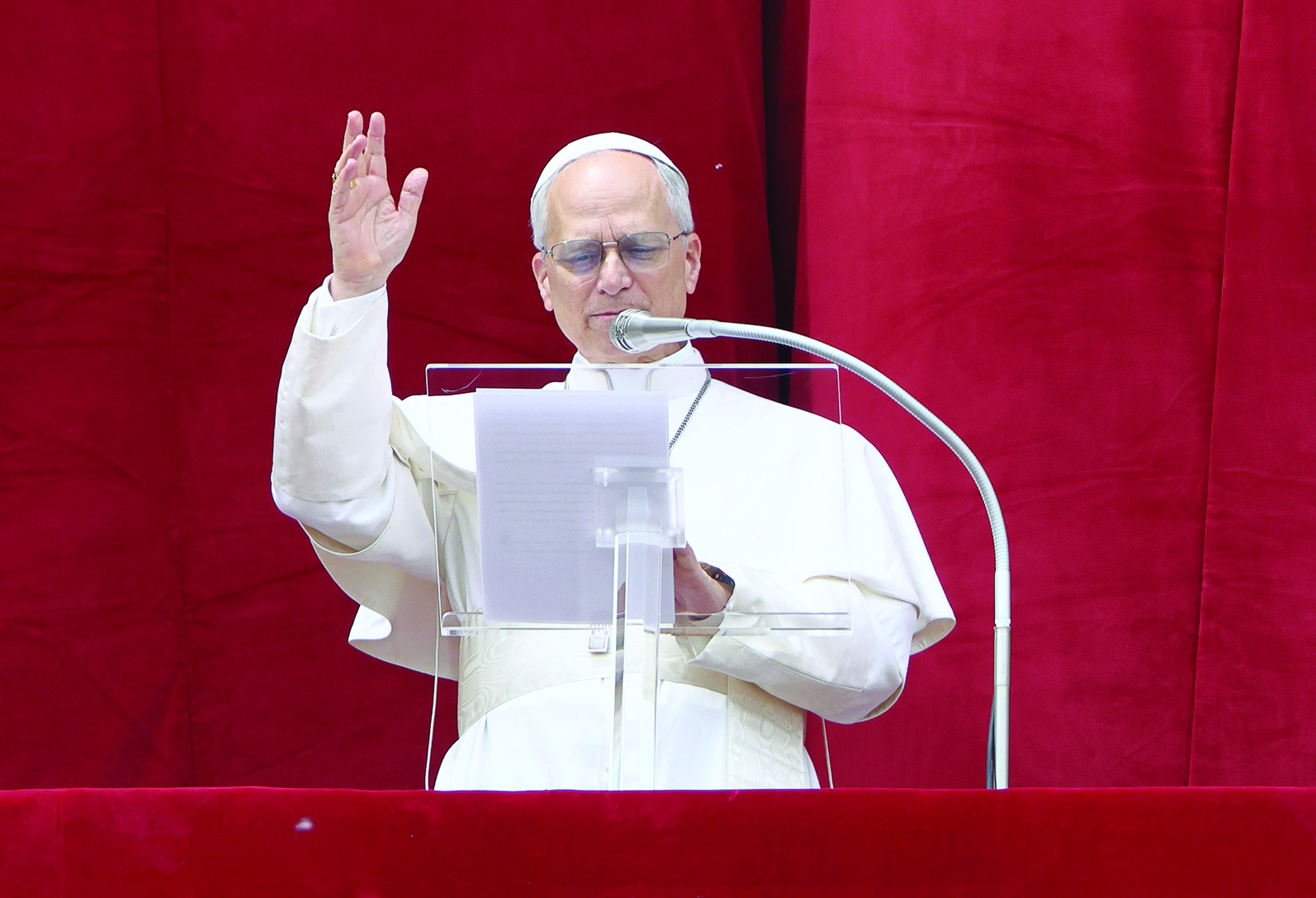

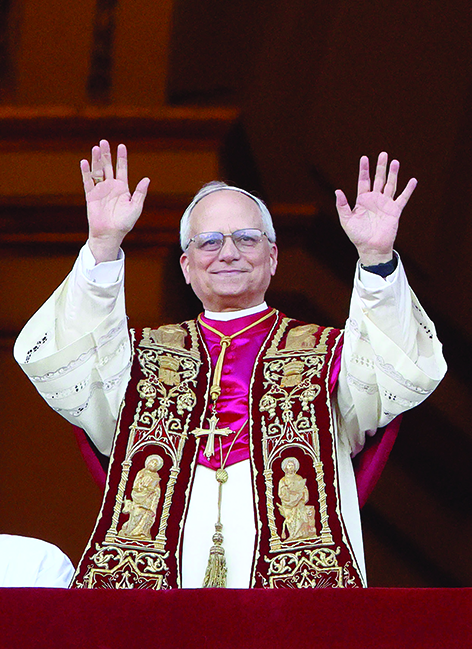
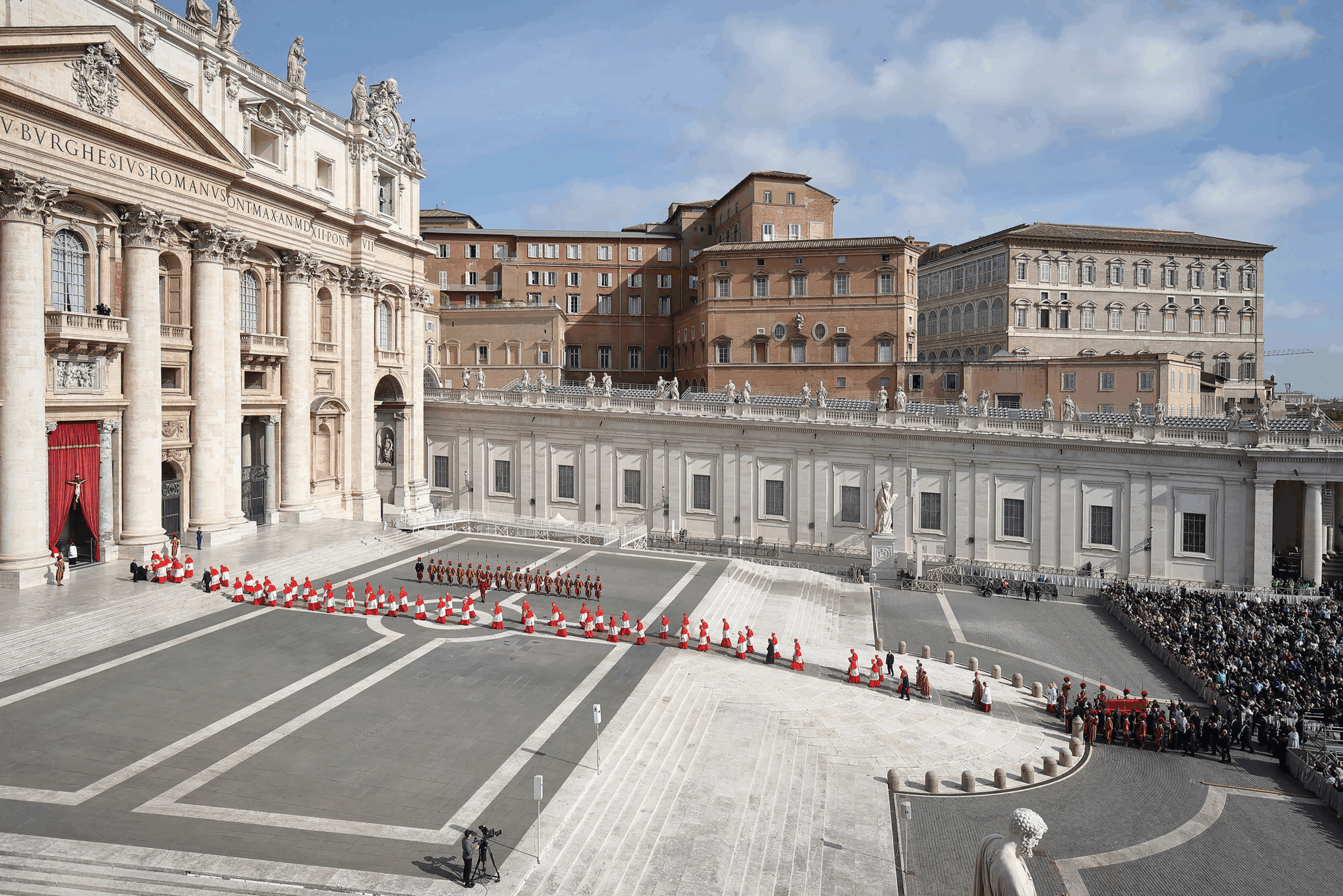
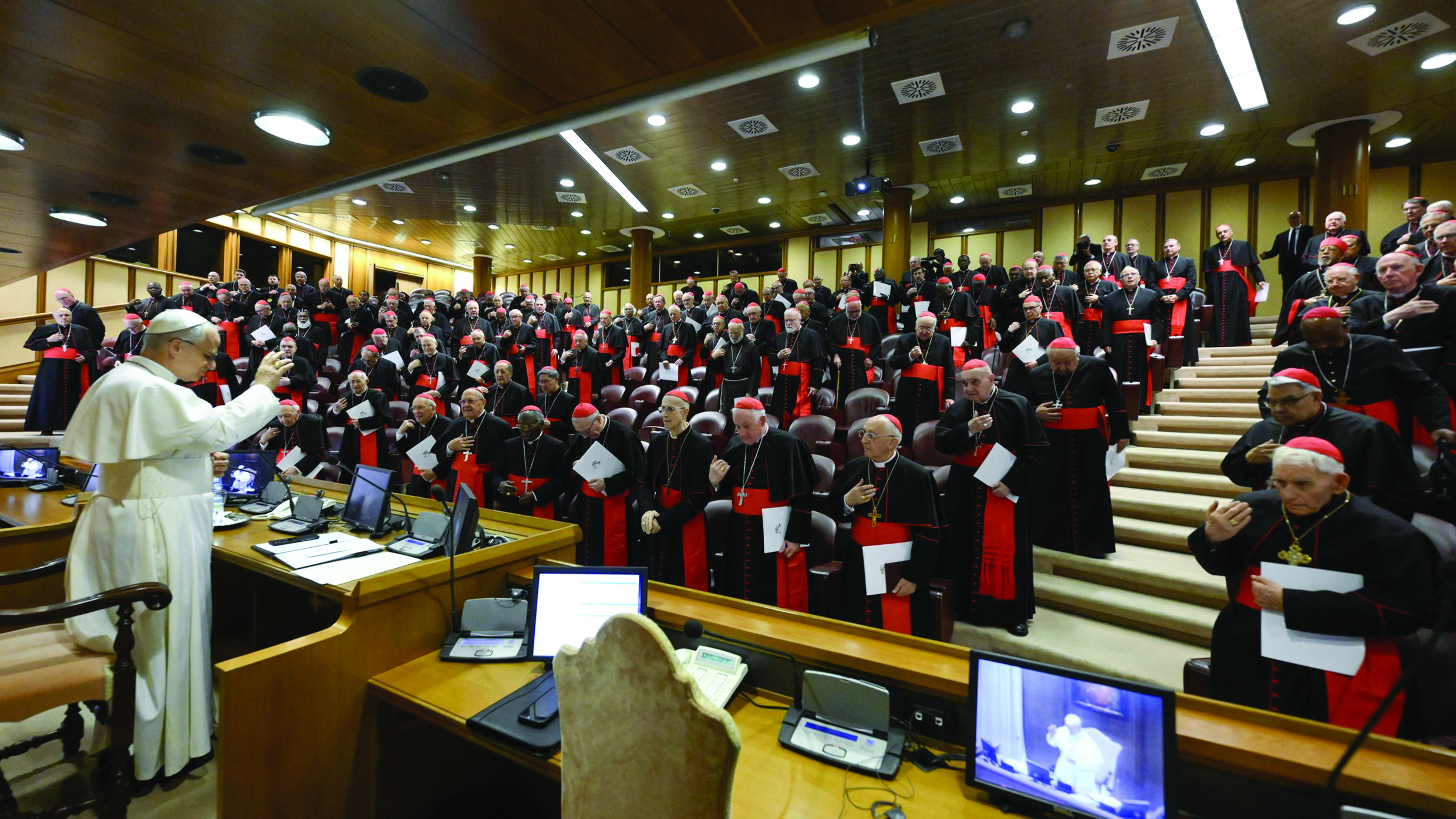
Facebook Comments